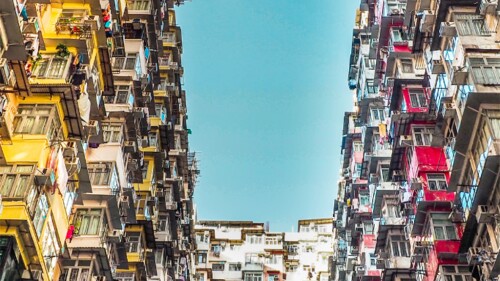ULI MEMBER–ONLY CONTENT: With recovery from the global pandemic well underway, China has areas of stability and opportunity that it can capitalize on as it enters the new year, panelists said at the 2020 ULI China Real Estate Investment Summit in December.
Discussing China’s macroeconomic outlook, as well as the real estate market and regulatory policy developments were Shuang Ding, chief economist for Asia and north Asia at London-based Standard Chartered, and Dr. Wei Zhong, professor of finance at Beijing Normal University; both spoke through translators. The summit offered a mix of virtual and in-person sessions, as well as tours of Shanghai. Zhong and Ding.
Outlook for GDP Growth
China’s growth in gross domestic product (GDP) is rebounding and is expected to accelerate this year, the speakers said. China’s GDP growth for 2020 is estimated at 2.1 percent, lower than the official goal of 6 percent and the lowest growth rate China has posted since 1976. Ding called it “quite decent,” all things considered. Indeed, China is expected to be the only G20 economy to have seen economic growth in 2020. Ding provided a conservative estimate of fourth-quarter growth of 5.5 percent, but because growth was accelerating, said he thought the actual figure would be higher.
Both Ding and Zhong predicted that GDP growth in 2021 will be 8 percent, in line with what others have predicted. Zhong expected that GDP in the first half of 2021 “will be skyrocketing,” with downward effects following in the third and four quarters.
Looking further out, Zhong predicted “very tough competition between China and the U.S. in the next two to three years,” and that by 2023, China’s per capita GDP could reach the threshold of high-income countries. (The World Bank currently classifies China as an upper-middle-income country). Notably, 2023 could also be the year China’s population peaks at 1.41 billion. Official estimates put the peak year at 2029, but given that the repeal of the one-child policy in 2015 has failed to deliver a hoped-for baby boom, other experts project it will occur sooner.
China’s long-term vision for 2035 emphasizes doubling GDP though a 5 percent annual GDP growth rate. If China can maintain that growth rate, Zhong noted, “there is a greater possibility that China may surpass the U.S. [GDP] by 2035.”
Stimulus Measures and Concern about Debt
The Chinese Communist Party’s annual Central Economic Work Conference concluded a few weeks after the ULI China Real Estate Investment Summit, and despite speculation that China would begin tapering stimulus, leaders are opting to continue stimulus policies into 2021.
“At this stage, China can talk about the exit strategy because . . . [the] overall economic development tendency is quite stable,” Ding at the ULI summit. “However, the government should pay attention to avoiding a policy cliff.”
Both speakers were concerned that prolonging China’s current expansive monetary and fiscal policy could end up increasing debt levels—especially among regional governments and corporations—which Zhong called “conspicuously high.” Debt has increased globally due to COVID, but both men see debt as one of China’s primary medium- to long-term challenges. “For the regional governments’ debt and for the corporate debt, about 85 percent is to use the new loans to pay for the old loans, so there will be some issues about insolvency,” Zhong said.
From 2008 to 2017, China’s debt ratio soared from 140 percent of GDP to 250 percent, Ding noted. The Institute for International Finance, a global financial industry association, estimated China’s aggregate debt at 335 percent of GDP in the third quarter of 2020. The central government took steps to de-leverage starting in 2016, but the pandemic slowed that trend, increasing budget deficits from 6 percent in 2019 to over 10 percent in 2020.
China introduced the “three red lines” in August, a set of thresholds designed to curb real estate development debt. Zhong thinks most publicly listed real estate firms in China cannot currently satisfy the three red lines, though they have until mid-2023 to do so. “How can we regulate all that debt? . . . This is a big challenge for the Chinese government,” he said.
Interest Rates and Currency
The Chinese Central Bank will leave interest rates unchanged, at least in part to avert the risk of increased defaults and a resulting financial crisis, Dong said. “There doesn’t exist an overheat, or overgrowth, in our economy, and we don’t have a foundation to raise interest rates,” he said. Inflation will also be low, totaling 0.9 percent for 2020 and hitting 1.5 percent by the end of 2021, he predicted.
Regarding currency, Ding predicted that the renminbi would stay strong through the first quarter of this year, reaching 6.3 to the dollar in mid-2021 and ending the year at 6.45. If vaccines drive recovery in developed economies, he predicted that by the fourth quarter, demand for Chinese products would decline, decreasing China’s current advantage and halting further strengthening of the renminbi.
Population, Housing Sector to Drive Growth
Looking further into the future, Zhong said that though the sales volume and price of Chinese commercial real estate had peaked in 2018, he sees no reason for pessimism. As an example, he cited the almost 900 million people who live in China’s urban areas, of whom 470 million live in homes built before 2000.
“Although China has enough [housing] stock, we need to improve our quality,” he said. Strong demand from 9 million newly supplied households—either through marriage or divorce—will further drive demand for housing, he added. However, inequality remains a significant concern. Despite millions of people having been lifted out of poverty over the past 30 years, over 17 percent of the Chinese population—237 million people—still live in poverty, and the poverty rate is five times higher in rural areas than in cities.
Both Ding and Zhong expect a very stable development environment in Chinese real estate over the next two to three years, though Zhong said policy changes related to real estate taxes are a possibility, given that regional governments rely mainly on land taxes to generate revenues. Land sales generated almost 53 percent of local government revenue in 2019, a record, according to the Wall Street Journal.
From January to October 2020, land-related activities generated 7.2 trillion RMB (US$1.1 trillion), Zhong noted, about 22 percent of which came from real estate development, with the rest coming from land sales and leasing. If regional government revenues from other sources trend downward, real estate taxes may eventually be increased, but for now, the government seems to be focused on managing debt levels while continuing to encourage economic recovery.
Learn more about upcoming ULI events in the Asia-Pacific region.




